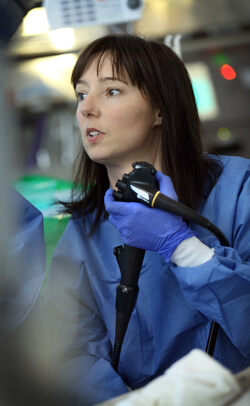Inside Tract
January 1, 2014

For years, the limits of medical imaging made the pancreas elusive. But as medical imaging improves by the day, so grows the number of bumps, lumps and question marks that appear on MRIs.
Studies indicate that as many as 14 percent of people who undergo magnetic resonance imaging show evidence of pancreatic cysts.
According to Anne Marie O'Broin-Lennon of Johns Hopkins Medicine's Division of Gastroenterology, who is the director of the Multidisciplinary Pancreatic Cyst Program at Johns Hopkins, the most important thing about pancreatic cysts is that a small number of them have the ability to turn into pancreatic cancer. "We know that pancreatic cancer develops slowly, over several years," she says. "And we believe that pancreatic cysts have a similarly slow progression. Therefore, we have the ability and the time to intervene."
O'Broin-Lennon says that the removal of a precancerous cyst leaves the patient with a greater-than 95 percent chance of survival.
"But if you wait until it becomes invasive cancer," O'Broin-Lennon says, "then your patient's chance of being alive in five years falls to between 20 and 30 percent. So we have a wonderful opportunity to intervene and to help them."
While this may mean a number of potentially lifesaving opportunities, she says, it doesn't necessarily translate into a lot of cyst removals at Johns Hopkins.
"It's true, our surgeons did something like 500 pancreatic resections last year," she says. "But we saw many more patients who didn't need surgery.
Monitoring for Pancreatic Cancer
"The vast majority of these pancreatic cysts will never turn into cancer. And the surgery itself isn't like having your appendix out; it's a major operation. So very often, the best option is to monitor the cysts."
O'Broin-Lennon and her colleagues on the multidisciplinary pancreatic team determine patient cancer risk in a number of ways. She points to the historic research published in 2001 by Bert Vogelstein of Johns Hopkins Medical Institutions. "Dr. Vogelstein found a set of genes that is extremely good at telling us exactly what type of cyst we're dealing with. We can tell with 98 percent accuracy."
She adds that Michael Goggins and other Johns Hopkins gastroentrologists collaborated on a study published last year that, among other things, found new ways to collect genetic material from the pancreas without risk of injury.
"Dr. Goggins found that you can get valuable samples from the pancreas without using a needle," she says. "He gave patients a shot of secretin-a safe, naturally occuring hormone-to stimulate the pancreas, then used the endoscope to collect pancreatic juice, which is full of the genetic markers that determine whether or not the patient is precancerous."
O'Broin-Lennon is confident in her team's approach. "I think what makes Johns Hopkins special is the huge depth of experience in our group," O'Broin-Lennon says. "Doctors, nurses, researchers, surgeons, pathologists and radiologists all consult and work together on every case.
"It really is remarkable. Pancreatic cysts are all we do. We saw more than 3,500 patients last year-all cysts."
